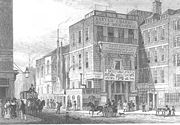
Cecil House
Encyclopedia

Strand, London
Strand is a street in the City of Westminster, London, England. The street is just over three-quarters of a mile long. It currently starts at Trafalgar Square and runs east to join Fleet Street at Temple Bar, which marks the boundary of the City of London at this point, though its historical length...
, in the vicinity of the Savoy. The first was a 16th century house on the north side, where the Strand Palace Hotel
Strand Palace Hotel
The Strand Palace Hotel is a large hotel on the north side of the Strand, London, England, positioned between Covent Garden, Trafalgar Square and the River Thames. It was built after Exeter Hall was demolished in 1907...
now stands. The second was built in the early 17th century on the south side nearly opposite, where Shell Mex House
Shell Mex House
Shell Mex House is situated at number 80, Strand, London, UK. The current building was built in 1930-31 on the site of the Hotel Cecil and stands behind the original facade of the Hotel and between the Adelphi and the Savoy Hotel. Broadly Art Deco in style, it was designed by the architectural...
is today.
Exeter House
The first, also called Exeter House or Burghley HouseBurghley House
Burghley House is a grand 16th-century country house near the town of Stamford, Lincolnshire, England...
, was on the north side of the Strand; it was built in the 16th century by Lord Burghley
William Cecil, 1st Baron Burghley
William Cecil, 1st Baron Burghley , KG was an English statesman, the chief advisor of Queen Elizabeth I for most of her reign, twice Secretary of State and Lord High Treasurer from 1572...
as an expansion of an existing house; Cecil moved his London residence there in 1560, and Queen Elizabeth supped with him there in July 1561 "before my house was fully finished", Cecil recorded in his diary, calling the place "my rude new cottage" in a letter; When Cecil was created Lord Burghley in 1571, this London seat became known as Burghley House. In fact it was a symmetrical double courtyard brick house of three storeys, with four-storey corner turrets. A central entrance led from The Strand into the front court At its garden front, with a central bay window and corner turrets, the house looked over gardens on grounds purchased from the Earl of Bedford and the earl's fields of Covent Garden
Covent Garden
Covent Garden is a district in London on the eastern fringes of the West End, between St. Martin's Lane and Drury Lane. It is associated with the former fruit and vegetable market in the central square, now a popular shopping and tourist site, and the Royal Opera House, which is also known as...
beyond. The garden included a mount with a spiralling path to its top, a paved tennis court, a bowling alley and an orchard.
The house became the residence of his elder son Thomas Cecil
Thomas Cecil, 1st Earl of Exeter
Thomas Cecil, 1st Earl of Exeter, KG , known as Lord Burghley from 1598 to 1605, was an English politician and soldier.-Life:...
, created Earl of Exeter in 1605; thus in Wenceslas Hollar
Wenceslas Hollar
Václav Hollar , known in England as Wenceslaus or Wenceslas and in Germany as Wenzel Hollar , was a Bohemian etcher, who lived in England for much of his life...
's bird's-eye view of London (ca 1658) it is labeled "Exeter House". The structure formed a notch in the north side of The Strand. It was converted in 1676 into Exeter Exchange
Exeter Exchange
The Exeter Exchange was a building on the north side of the Strand in London, with an arcade extending partway across the carriageway...
and demolished in 1829.
Salisbury House
The second, more commonly known as Salisbury House, was built on the waterfront opposite the existing house, by Burghley's younger son Robert Cecil, created Earl of SalisburyRobert Cecil, 1st Earl of Salisbury
Robert Cecil, 1st Earl of Salisbury, KG, PC was an English administrator and politician.-Life:He was the son of William Cecil, 1st Baron Burghley and Mildred Cooke...
, around the turn of the 17th century. It was divided by his heir the second Earl
William Cecil, 2nd Earl of Salisbury
William Cecil, 2nd Earl of Salisbury, KG , known as Viscount Cranborne from 1605 to 1612, was an English peer and politician.-Early years, 1591-1612:...
into two parts, of which the lesser was demolished in 1678 to make room for a new residential street, Salisbury Street. The central part of the building was converted to shops, and officially renamed the Middle Exchange, though colloquially the building was of ill repute, being known as the Whores' Nest; this part of the building was finally demolished around 1695, along with the remainder of the house, to make room for a new road named Cecil Street. The site was subsequently used for the Hotel Cecil
Hotel Cecil (London)
The Hotel Cecil was a grand hotel built 1890–96 between the Thames Embankment and the Strand in London, England. It was named after Cecil House , a mansion belonging to the Cecil family, which occupied the site in the 17th century.Designed by architects Perry & Reed in a "Wrenaissance" style, the...
, named for this house, and is currently occupied by Shell Mex House
Shell Mex House
Shell Mex House is situated at number 80, Strand, London, UK. The current building was built in 1930-31 on the site of the Hotel Cecil and stands behind the original facade of the Hotel and between the Adelphi and the Savoy Hotel. Broadly Art Deco in style, it was designed by the architectural...
.

